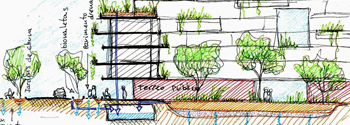DWELLING IN ‘BUFFER ZONES’: ECO-SOCIAL GUIDELINES FOR AN ARCHITECTURE INTEGRATED TO GREEN INFRASTRUCTURE
DOI:
https://doi.org/10.11606/issn.2179-2275.v8i2p91-127Keywords:
Architecture, Urbanism, Sustainable Design, Urban Ecological ResilienceAbstract
The Green Infrastructure research occurs mainly through the landscape design and the reconstitution of the urban forest. This important emphasis guides changes to face the current environmental challenges. In this conceptual and practical effort, an extremely important issue arises: how can the architectural project, together with the fulfillment of its social functions, contribute to the ecosystem services provided by the Green Infrastructure? The building, usually an obstacle to ecosystemic processes, obstructs or conditions its flows through designs in conflict with an ecological approach. By proposing the architectural design as a factor of contribution to urban ecological resilience, it is suggested to dilute the border lines between construction and landscape, integrating the building with the green infrastructure and redefining its functions beyond the traditional architectural program.Downloads
References
BENEDICT, Mark A.; MCMAHON, Edward T. Green Infraestructure – Linking landscapes and communities. Washington: Island Press, 2006.
BONZI, Ramón Stock. Andar sobre Água Preta: a aplicação da Infraestrutura Verde em áreas densamente urbanizadas.
FRANCO, Maria Assunção Ribeiro. Planejamento ambiental para a cidade sustentável. São Paulo: Annablume,FAPESP, 2001.
GEHL, Jan, Cities for people. Washington DC: Island Press, 2010.
GUNDERSON, Lance H; ALLEN Craig R.; HOLLING, C. S.. Foundations of ecological resilience.
GUNDERSON, Lance H.; HOLLING, C.S. Panarchy, understanding transformations in human and natural systems. Washington: Island press, 2002.
HASS, Tigran (editor). Sustainable Urbanism and Beyond. Nova Iorque: Rizzoli, 2012
HILLMAN, James. Cidade e alma. São Paulo: Studio Nobel, 1993
HOUGH, Michael. Cities and natural process. London: Routledge, 1995.
KATZ,P. (org). The new urbanism – Toward an architecture of community. New York: Mc Graw-Jill, 1994.
LOTUFO, José Otávio. Oikos: Reintegrando natureza e civilização. Em, Revista LABVERDE n. 02. São Paulo: FAU-USP, 2011.
LOTUFO, José Otávio. Projeto Sustentável – Resiliência Urbana para o bairro da Pompéia. Tese de Doutorado, FAU-USP, 2016.
MOSTAFAVI, Mohsen ; DOHERTY, Gereth. Ecological urbanism. Baden: Lars Müller, 2010.
ORBELLE, Oscar; YANNAS, Simos. Em Busca de uma Arquitetura Sustentável para os Trópicos. Rio de Janeiro: Revan, 2003
PEVSNER, Nikolaus. Visual planning and the picturesque. Los Angeles: Getty, 2010
PICKETT, S.T.A.; CADENASSO, M.L.; MCGRATH, Brian. Resilience in ecology and urban design – Linking theory and practice for sustainable cities. New York/London: Springer, 2013.
SÃO PAULO. Câmara Municipal. Lei 16.050/14, Plano Diretor Estratégico. São Paulo: Câmara Municipal, 2014
SCHUTZER, José Guilherme. Cidade e meio ambiente – A apropriação do relevo no desenho ambiental urbano. São Paulo: Edusp, 2012.
WALDHEIN, Charles (org.). The landscape urbanism reader. New York: Princeton Architectural Press, 2006.
YEANG, Ken. Proyectar con la naturaleza. Barcelona: GG, 2007.

Downloads
Published
Issue
Section
License
O detentor dos direitos autorais é o autor e eventuais coautores do artigo. A Revista LABVERDE exige apenas o ineditismo na publicação do artigo. O autor tem o direito de divulgar seu artigo conforme sua conveniência devendo citar a revista.
A Revista LABVERDE autoriza a republicação de seus artigos desde que devidamente citada fonte e autoria.


